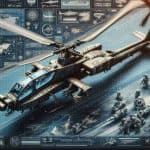The Eurofighter Typhoon, often simply referred to as the “Typhoon,” is a multirole fighter aircraft that continues to be a cornerstone of air defense for several air forces around the world. Originally designed through collaboration among European nations, the Typhoon has stood the test of time due to its versatility and cutting-edge technology.
First taking to the skies in 1994, the Typhoon was the result of a cooperative effort by Germany, Italy, Spain, and the United Kingdom, with contributions from aerospace giants like Airbus, BAE Systems, and Leonardo. Its primary role is to achieve air superiority, but it also performs ground attack operations with precision and efficiency.
Equipped with advanced avionics and a sophisticated fly-by-wire control system, the Typhoon is designed for agility and high-speed engagement. Its twin Eurojet EJ200 engines enable it to reach speeds over Mach 2, ensuring it can intercept and engage adversaries swiftly. Pilots enjoy an advantage with the aircraft’s helmet-mounted symbology system, which allows critical information to be projected into their field of vision.
Despite entering service over two decades ago, ongoing upgrades remain pivotal in keeping the Typhoon relevant in modern warfare. These enhancements include integration with the European Common Radar System and updated weapons systems, maintaining the Typhoon’s reputation as one of the most formidable fighter jets in the skies today.
With over 600 units produced, the Eurofighter Typhoon continues to be a symbol of European engineering prowess and collaborative defense strategy, safeguarding the airspaces of nations across the globe.
The Hidden Costs: Who Really Bears the Burden of the Eurofighter Typhoon?
Despite the Eurofighter Typhoon’s successful legacy as a key player in global air defense, its development and operational costs have sparked debate over economic and strategic implications for participating countries. While technological advancements are undeniable, the financial strain on national budgets raises questions about the sustainability of such high-priced defense projects.
Why Are Development Costs So Controversial? The Typhoon’s joint development came with an initial price tag that soared far beyond early projections. Contributing countries faced budget overruns, leading to increased scrutiny over defense spending. The complexities of multinational cooperation often result in time delays and cost increases, as seen in this ambitious project.
Who Benefits from the Eurofighter? While manufacturers like Airbus, BAE Systems, and Leonardo have reaped financial rewards, critics argue that socio-economic benefits to the contributing nations are uneven. Jobs created through production and maintenance are significant, yet questions remain about opportunities for smaller businesses within these countries’ supply chains.
What’s the Future for Such Collaborations? As defense budgets continue to strain national resources, is the collaboration model sustainable? Could smaller, more agile projects offer more economic efficiency? These are critical considerations for future international defense strategies.
For more insights into global defense strategies, visit Reuters or explore the world of aviation technology at Airbus.
Ultimately, while the Eurofighter Typhoon represents a marvel of modern engineering and international collaboration, its financial and strategic complexities provoke ongoing debate over the true cost of peace and security.
The article has been updated: 2024-11-07 16:06
Here are some related links to consider:
1. U.S. Air Force – Official website of the U.S. Air Force, providing news, information, and resources about their aircraft, missions, and advancements in technology.
2. Lockheed Martin – A major aerospace and defense company that provides insights on military aircraft and technologies, including advanced fighter jets and defense solutions.
3. Boeing – A leading manufacturer of military aircraft, offering information about the latest innovations and technologies in aeronautics.
4. U.S. Department of Defense – The official site of the U.S. Department of Defense, featuring updates on military operations, strategic initiatives, and advancements in air power.
5. FlightGlobal – A valuable resource for aviation news, including features on military aircraft, advancements in aerospace technology, and industry trends.
6. IndustryWeek – A publication that covers manufacturing and technological advancements, including those related to aerospace and defense sectors.
7. Janes – A trusted source for defense and security information, focusing on equipment, defense capabilities, and military analysis.
8. Air Force Magazine – The official publication of the Air Force Association, providing analysis and commentary on air power and developments within the U.S. Air Force.
9. Aerospace Technology – An online resource featuring news and insights into aerospace developments, including military aircraft and air defense systems.
10. Military.com – A comprehensive military news website that covers various aspects of armed forces, including news on fighter jets and air superiority technologies.
The article has been updated: 2024-11-08 08:46
What features make the Air Force Typhoon a dominant force in modern air combat?
The Air Force Typhoon is considered a dominant force in modern air combat due to its advanced technology, exceptional agility, and multi-role capabilities. Its state-of-the-art avionics and sensor fusion allow pilots to maintain superior situational awareness and engage multiple targets effectively. The aircraft’s thrust-vectoring engines provide outstanding maneuverability, enabling it to outmatch adversaries in dogfights. Additionally, the Typhoon’s ability to perform both air-to-air and air-to-ground missions enhances its versatility, allowing it to excel in various combat scenarios. Its integration of advanced weapons systems, including long-range missiles and precision-guided munitions, further solidifies its status as a centerpiece of air superiority.







